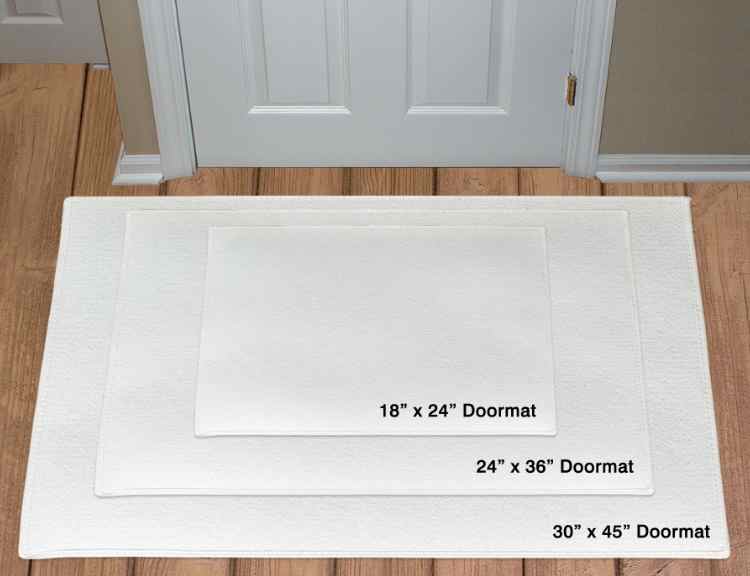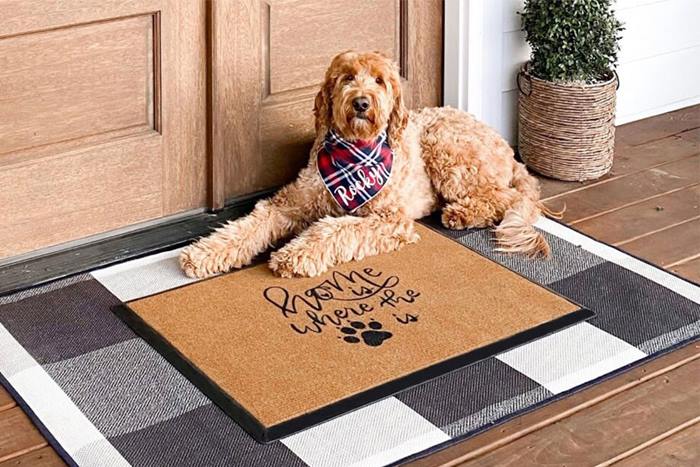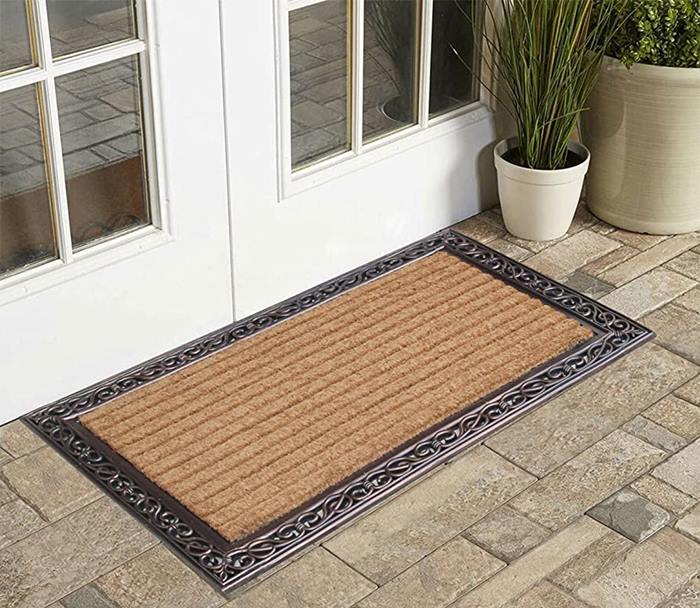Creating a welcoming entrance to your home starts with choosing the right size doormat. The size of your doormat should be appropriate for the space in front of your door and accommodate visitors comfortably as they enter.
This article provides tips and tricks to help you select the perfect standard doormat size for your home.
From measuring doorsills to considering the size of your guests, we will discuss everything you need to know to make an informed decision.
With this advice, you can find a doormat that is stylish and practical for everyone who visits your home.
What is the standard size for a doormat?

Finding the right doormat size can be tricky if you don’t know what kind of door you are working with.
Standard interior door widths are 30 inches, while standard outside doors measure 36 inches.
Knowing this information will make it easier for you to pick out the perfect doormat for your space.
A smaller mat would fit nicely in front of an interior door, while a larger one is better suited to the outdoors. You can also get creative by picking out a customized doormat that fits the exact dimensions you are looking for!
Whichever size you choose, make sure it’s wide enough to fit the full width of your door and give your guests a friendly welcome.
The standard size for a doormat is typically 18 inches by 24 inches (45 x 60 cm). This size is considered ideal for most front doors and is large enough to accommodate foot traffic.
However, it is important to note that doormats come in various sizes, shapes, and materials to suit different preferences and requirements.

The most common sizes are:
Small Size (STANDART) – 18 x 24 inches (45 x 60 cm)
Small doormats typically measure around 16 x 24 inches. They are suitable for narrow entryways or areas with limited space. They can also be used in front of individual doors, such as bathroom or closet doors.
Medium Size – 24 x 36 inches (60 x 90 cm)
Medium doormats are larger than small doormats, measuring around 18 x 30 inches. They are ideal for most entryways, including front doors, back doors, and garage doors.
Large Size – 36 x 48 inches (90 x 120 cm)
Large doormats measure around 24 x 36 inches. They are suitable for larger entryways, such as double doors, sliding doors, or French doors.
How to measure for the right size doormat?

Before purchasing a doormat, it is essential to measure the space where you intend to place it. This will help you determine the correct size of the doormat you need. To measure for the right size, follow these steps:
- Measure the width of your door: Use a measuring tape to measure the width of your door from the inside of the door jamb. This will give you an idea of the maximum width of the doormat you can choose.
- Measure the depth of your entryway: Measure the depth of your entryway from the door to the inside of your home. This will give you an idea of the maximum depth of the doormat you can choose.
- Choose a doormat that is proportionate to your entryway: Once you have the width and depth measurements, choose a doormat that is proportionate to your entryway. If your entryway is narrow, choose a smaller doormat. If your entryway is wide, you can choose a larger doormat.
Different Door Mats Types:

- Traditional Coir Doormats: Made from coconut fibers, these doormats are durable and have a classic, natural look.
- Rubber Drainage Doormats: These doormats are resistant to weather and can handle muddy shoes. They come in various patterns and textures.
- Anti-Fatigue Doormats: These doormats are designed to provide support and relieve pressure on the feet, making them ideal for people who stand for long periods of time.
- Boot Trays: These are shallow trays that are used to hold shoes and boots to prevent mud and dirt from getting inside the house.
- Waterhog Doormats: These doormats are made with a unique waffle pattern that is designed to trap water, dirt, and mud. They are perfect for wet or snowy climates.
- Natural Fiber Doormats: Made of natural materials like jute or sisal, these doormats are eco-friendly and have a rustic feel.
- Seasonal Doormats: These doormats feature seasonal designs and colors, making them a fun and festive addition to any entryway.
- Novelty Doormats: These doormats come in a variety of unique designs, from humorous messages to pop culture references, adding a touch of personality to your entryway.
Factors to Consider When Choosing the Right Doormat

When choosing the right doormat, there are several factors to consider beyond just its size.
The material, thickness, and foot traffic are all important considerations that can impact the mat’s effectiveness and durability.
The thickness of the doormat can impact its effectiveness in trapping dirt and moisture. A thicker mat can provide better absorption and durability, but it may also be more difficult to clean and maintain.
On the other hand, a thinner mat may be easier to clean but may not provide adequate protection against dirt and moisture.
The length of a doormat can vary depending on the size of the entrance it will be placed in. A larger entrance may require a longer mat to adequately cover the area and provide sufficient protection against dirt and debris being tracked inside.
On the other hand, a smaller entrance may only require a shorter mat to serve its purpose. Additionally, the length of the mat can also affect its appearance, with longer mats often appearing more substantial and impressive.
Clearance is another crucial factor in determining the appropriate size of a doormat. Clearance refers to the space between the bottom of the door and the floor.
A doormat that is too thick or high may not fit underneath the door, causing an obstruction or even preventing the door from opening and closing properly. It is essential to measure the clearance of the entrance and choose a mat that fits comfortably within these parameters.
The width of a doormat can impact its effectiveness in trapping dirt and moisture. A wider mat can provide more coverage and reduce the likelihood of dirt and debris being tracked inside.
However, wider mats may not be suitable for narrow entrances or those with limited space. It is essential to consider the width of the entrance and choose a mat that will fit comfortably without creating an obstacle or hazard.
Foot traffic is another critical factor to consider when choosing the right doormat. An entrance with heavy foot traffic may require a more durable and thicker mat that can withstand constant wear and tear.
Additionally, high-traffic areas may require more frequent cleaning and maintenance to ensure the mat remains effective in trapping dirt and moisture
The material of the doormat is an essential consideration. Different materials have varying levels of absorption and durability.
For example, a coconut fiber mat may be suitable for an outdoor entrance with heavy foot traffic, while a cotton or nylon mat may be better suited for an indoor entrance with less traffic.
By choosing a mat made from the appropriate material, you can ensure that it effectively traps dirt and moisture while providing the necessary durability for its intended use.

conclusion
Taking the time to ensure you pick out the right door mat size will save you time and money in the long run. Having a doormat that’s too small for your doorway will quickly look cluttered, and having one that’s too large isn’t particularly attractive either.
Don’t forget to take into account factors like weather and climate, as these play an integral part in determining not only which size doormat is right for your home but also which type of material makes sense.
Who knows, your old welcome will be as warm and inviting as ever before with a stylish, new doormat! Best of luck finding the perfect one for your entryway– we can’t wait to hear how your story turns out.
Other related articles that you might also like:
7 Best Outdoor Door Mats That Drain Water

